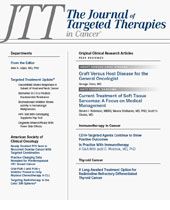HPV Test With Genotyping Supplants Pap Test
Cervical cancer screening based on identification of human papillomavirus (HPV) outperformed primary liquid cytology for detection of high-grade cervical intraepithelial neoplasia (CIN).
Thomas C. Wright Jr, MD

Thomas C. Wright Jr, MD
Cervical cancer screening based on identification of human papillomavirus (HPV) outperformed primary liquid cytology for detection of high-grade cervical intraepithelial neoplasia (CIN), according to data from a large cohort study. Compared with 4 other screening strategies, primary HPV testing with HPV 16/18 genotyping and reflex cytology offered the best combination of sensitivity and efficiency. The approach detected the most cases of CIN grade 3 (CIN3+), missed the fewest cases, and required 12.8 colposcopies to detect 1 case of CIN3+.
“All of the primary HPV strategies are more sensitive for CIN3+ than cytology with ASC-US [atypical squamous cells of undetermined significance] triage,” said Thomas C. Wright Jr, MD, of Columbia University in New York City. “Primary HPV screening with 16/18 genotyping and reflex cytology for 12 other high-risk HPV strains is the most sensitive approach and results in only slightly more colposcopy than hybrid cotesting; it also requires far fewer screening tests,” Wright explained.
Cotesting with cytology and HPV analysis resulted in a slightly lower rate of colposcopies per CIN3+ case detected, but required 73% more screening tests. Other strategies proved to be less sensitive for detecting CIN3+, as reported at the Society of Gynecologic Oncology meeting in Tampa, Florida.
The results came from analysis of the pivotal ATHENA trial, which provided support for the US Food and Drug Administration (FDA) approval of the cobas HPV Test. The study involved 40,901 women 25 years or older who had valid baseline cotesting with liquid-based cytology plus 3 HPV tests: Amplicor, Linear Array, and the cobas HPV Test, all of which detect HPV 16/18 and a pool of 12 other high-risk HPV strains.
Patients who had positive HPV tests or abnormal cytology (ASC-US) on baseline screening were referred for colposcopy (n = 8067), as were a random sample of patients who were HPV negative and had normal cytology (n = 895). Patients who had negative HPV tests and cytology exited the study.
During a 3-year follow-up period, patients continuing with the study had annual gynecologic examinations that included liquid-based cytology and highresolution HPV testing.
During follow-up, women who developed ASC-US were referred for colposcopy but remained in the study unless CIN2+ was detected. After 3 years, all these women (n = 4063) had repeat colposcopy with cervical biopsy.
Wright reported results for detection of CIN3+ by 5 screening strategies: cytology alone, cotesting, HPV with genotyping, HPV and reflex cytology for patients with positive tests, and HPV with genotyping and reflex cytology. Cytology alone detected 143 cases of CIN3+ at baseline and an additional 36 cases during follow-up, but missed 168 cases detected by HPV testing. The strategy was associated with 43,521 screening tests, leading to 1927 colposcopy procedures, and a colposcopy rate of 10.8 per each case of CIN3+ detected.
Cotesting detected 143 cases of CIN3+ at baseline and 140 during follow-up but missed 64 cases. The strategy involved 91,156 screening tests, 3527 colposcopy procedures, and detected a colposcopy rate of 12.5 per CIN3+.
HPV with genotyping identified 150 cases of CIN3+ at baseline and 126 during follow-up but missed 71 cases. Performance parameters consisted of 49,830 screening tests, 3218 colposcopies, and a colposcopy rate of 11.7 per each detected case of CIN3+.
HPV detection with reflex cytology identified 133 cases of CIN3+ at baseline and 138 cases during follow-up but missed 76 cases. The strategy involved 54,098 screening tests and 3191 colposcopy procedures, resulting in a colposcopy/ CIN3+ rate of 11.8.
The combination of HPV with genotyping followed by reflex cytology detected 294 cases of CIN3+ (197 at baseline and 97 during follow-up) and missed 53 cases. The strategy resulted in 52,651 screening tests, 3767 colposcopies, and a colposcopy/CIN3+ rate of 12.8.
On April 24, 2014, the FDA approved the cobas HPV Test as the first human papillomavirus test for primary cervical cancer screening in women 25 years and older, supplanting the Papanicolaou test, or Pap test as the primary screen for cervical cancer.

Gasparetto Explains Rationale for Quadruplet Front Line in Transplant-Ineligible Myeloma
February 22nd 2025In a Community Case Forum in partnership with the North Carolina Oncology Association, Cristina Gasparetto, MD, discussed the CEPHEUS, IMROZ, and BENEFIT trials of treatment for transplant-ineligible newly diagnosed multiple myeloma.
Read More